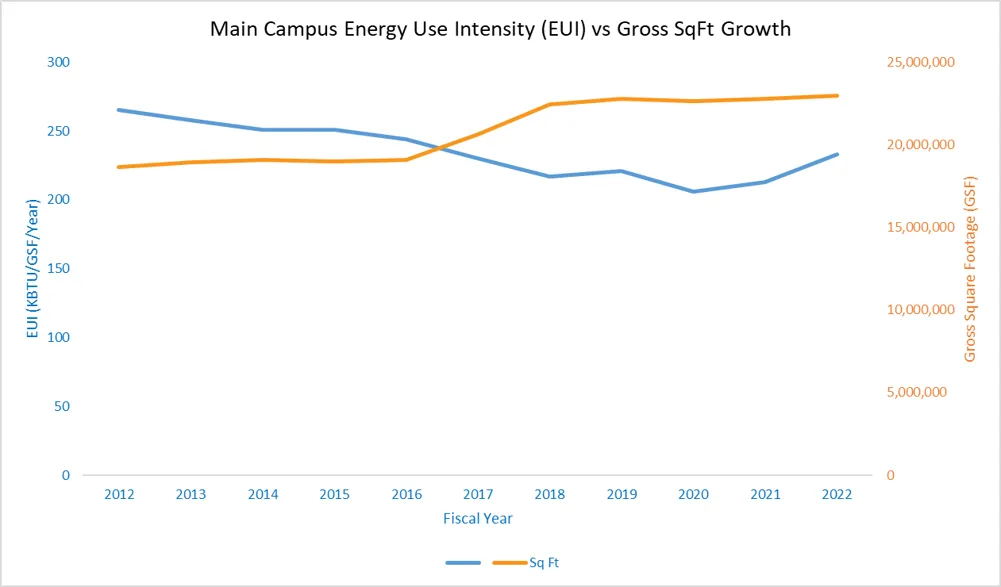In 2012, the Energy Management and Strategic Programs (EMSP) team was tasked with the goal of reducing campus buildings' energy use intensity (EUI) by 20 percent by 2020, using 2009 data as the baseline. Through innovative demand-side energy management strategies, that goal was reached in January 2018.
The graph below shows the overall EUI* progression for the UT Austin campus.

Since the EUI goal was reached two years early, a new goal was established based on the Demand-Side Strategic Plan (DSSP) for energy management. The DSSP provides a roadmap of energy goals and priorities for UT Austin over the next 15 years. The goal is to reduce campus-wide EUI by two percent annually, which will offset the projected campus energy growth.
The DSSP is based on the 2012 Campus Master Plan.
Demand-Side Energy Management Strategies
The EMSP team works with key staff to optimize building operations and employ energy conservation measures on the UT Austin campus. Below are some of the strategies utilized to make campus buildings more efficient and bring the team closer to its goal of an annual two percent energy reduction.
Savings are calculated using the Measurement and Verification Framework.
Campus-wide Energy Conservation Measures
Through careful examination of meters, trends and models, EMSP staff identify buildings across campus that are not operating as efficiently as they could. Depending on a building's level of automation, various energy conservation measures (ECMs) are implemented. Examples of these ECMs include:
- HVAC unit occupancy scheduling
- System shutdown programming
- Cold deck/hot deck set point resets
- Fan static pressure set point resets
- Terminal box setback programming
- Pump differential pressure set point resets
- Air-side economizer optimization
- Minimizing simultaneous heating and cooling
- Lighting retrofit or delamping
- Valve replacements
Savings are calculated using the Measurement and Verification Framework.
HVAC Equipment Scheduling
The EMSP team identifies buildings where heating, ventilation, and air conditioning (HVAC) systems can safely be set back during unoccupied operating hours – usually overnight, on weekends, and during some university holidays and breaks. During these times, the EMSP team coordinates with campus stakeholders, occupants, and building managers to make adjustments to low-occupancy and non-environmentally sensitive spaces. There are currently 66 buildings on a weekend and overnight schedule, with an average reduction of 17%.
The team also implements extended holiday scheduling over the Thanksgiving and winter breaks.
Existing Building Commissioning
Existing building commissioning (EBCx) is a systematic process that seeks to improve how building equipment and systems function together. The EMSP team follows ASHRAE Guideline 0-2019, The Commissioning Process. Additional guidelines and information on the commissioning process can be found by visiting the Building Commissioning Association.
The EBCx process is divided into two phases: performing an energy audit and implementing ECMs, such as those listed above. During the energy audit, the EMSP team will:
- review original project documents
- use energy analysis tools
- analyze the building automation system (BAS) for the mechanical system's sequences of operations and trends
- collect customer feedback
- perform onsite investigations
If any deficiencies are found, EMSP will work with Facilities Services' Maintenance Operations and Building Operations to repair and re-program the affected building's mechanical system and implement other ECMs. Their efforts benefit the university through improved occupant comfort, better indoor air quality, and increased building system efficiency.
Campus buildings that have undergone the EBCx process typically result in a 20 percent avoidance of energy usage.
New Construction and Renovations Energy Requirements
The EMSP team works with Campus Planning and Construction (CPC) and Project Management and Construction Services (PMCS) to ensure new buildings and major renovations are designed and constructed to be as energy efficient as possible. Below are the guidelines for new constructions projects:
New Construction Target EUIs
New campus buildings are designed to meet Energy Utilization Index (EUI) targets. Increased efficiency results in a lower EUI. After a building is constructed, the EMSP team tracks the building's energy use to ensure the target is met. Target EUIs for new construction projects can be found in the Energy Performance Information Request below.
New Construction Energy Performance Information Request
The Energy Performance Information Request was developed to assist design and construction teams in maximizing energy efficiency of new construction and major renovation projects. It lays out requirements for energy models, target EUIs, and commissioning requirements. The document also allows the EMSP team to track results of energy modeling used during design to predict energy performance and lays out a plan to verify that the EUI target is met within the first year after the building is occupied.
New Construction Commissioning Requirements
Building commissioning on new construction projects is the process of verifying that building equipment and systems (e.g., lighting, air conditioning) are installed, tested, and working properly. The EMSP team works with the building commissioning agent to address any issues found during construction. The groups continue to work together the first year after a new building opens to ensure the energy and performance targets are being met. If targets are not being met, the commissioning agent will investigate past equipment behavior and energy usage data to resolve the problem. See more information on diagnostic tools.
*EUI is determined by dividing a building’s total annual energy consumption, in MMBtu, by its square footage. This is done to normalize the energy consumption of buildings of different types and sizes to compare their relative energy efficiency level. Generally, a low EUI indicates a more efficient building and a high EUI indicates a less efficient building. However, some buildings, such as laboratories, will always have a higher EUI compared to offices or classrooms.
Questions?
For more information on campus optimization efforts, contact: energysteward@austin.utexas.edu.
